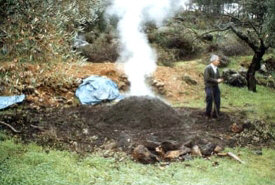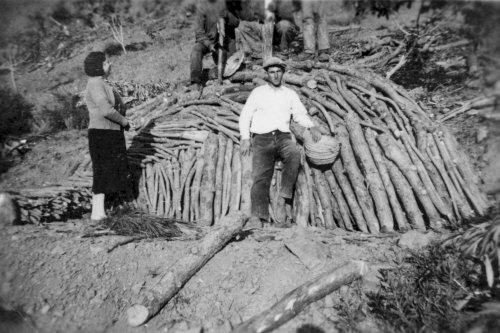|

THE
CHARCOAL BURNERS
One of the most established occupations in
the region was that of charcoal burner. The
charcoal burner undertook very hard work in
all weather conditions. During the
production of charcoal, there was no time to
sleep or rest. Day and night, the charcoal
burner had to control several ovens in
different stages of the process, demanding
constant vigilance.
The charcoal burner had a ghostly
appearance, with a face obscured by charcoal
and clothes torn by firewood. His diet was
not varied and his workplace was the
woodland. Despite the gruelling nature of
his work, the charcoal burner was a person
who accepted his position with dignity.
Obtaining charcoal
The preparation of the firewood depended on
its type and the place in which it was
found. Wood from pollarded trees (Cork Oak,
Chestnut, Portuguese Oak, Red Oak) was
obtained by cutting the tree through the
trunk and once felled, pruning the branches
and cutting up the trunk. In the event that
branches were used for firewood (rock roses,
junipers), the tips and thin branches not
suitable for making charcoal were removed.
Next the ground used for charcoal
manufacture had to be chosen and prepared. A
pit was dug in roughly circular form. The
floor of the kiln had to be compacted down
to prevent air entering through it since the
presence of air currents would make it very
difficult to control the fire during
charring.
Once the floor was cleared and the firewood
placed close by, the kiln was prepared and
set up. First a stake was set vertically
into the centre of the circular hole. Next
the wood was placed around the stake forming
a cone, trying to distribute it uniformly so
that cracks would not appear whole being
roasted.
The kiln was covered with a layer of
bracken, turf, moss or dead leaves. At that
point the stake placed in the centre was
removed and the hole (the future chimney)
was covered to prevent the earth from the
top layer falling in. The exterior cover
insulates the wood from the outside, so that
the oxygen in the air does not ignite it. A
correct charring is simply the slow and
incomplete combustion of wood due to lack of
oxygen.

Close to the kiln a small fire was lit, and
the hot coals obtained were thrown into the
mouth of the kiln. Once the fire reached
sufficient strength to not go out, the
chimney was capped, first being covered with
bracken and then by earth. From this point
on, it all has to be carefully watched,
particularly during the first ten hours,
which is when the clamp to burn. During the
charring process, the wood reduces in
volume, so it has to be beaten down and in
this way the charcoal already produced is
compacted to reduce the gaps that are
produced.
If the roast is too fast, the charcoal
burns, leaving only cinders. If the roast is
too slow, the charcoal would not be evenly
cooked, giving only partly charred wood. For
these reasons, the charcoal burner would
have to open ventilation holes in the parts
where the temperature is less, and block off
the areas where the temperature was higher,
trying to achieve a uniform intensity of the
fire at the different heights of the kiln.
The burning process occurred from the top
downwards, and from the centre outwards. The
duration of this process varied, depending
on the size of the kiln, taking around one
week.

Once the roasting was completed, the kiln
had to be extinguished and cooled, for which
the burnt earth was removed in order to
cover the ventilation holes and in that way
put out the small pockets of fire that were
still burning on the inside.
The only thing left was to bag up and
transport the charcoal. The charcoal burners
themselves packed it into a bag, closing it
with a piece of string stitched through the
mouth of a sack. Finally, they carried the
sacks on their backs to the loading area.
The most usual form of transport was by
pack-animal, driven by muleteers, taking the
charcoal to their destinations.
|